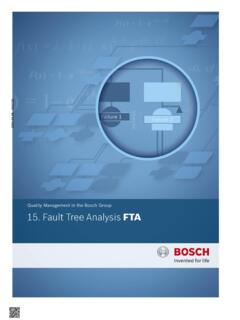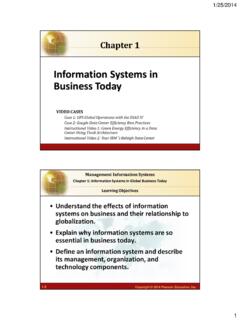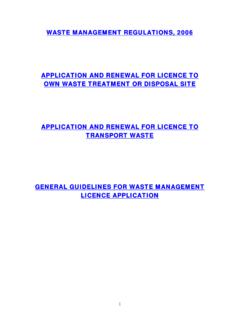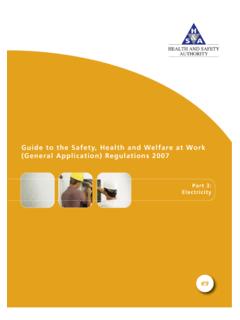Transcription of Booklet No. 14 Failure Mode and Effects Analysis FMEA
1 14. Failure Mode and Effects AnalysisFMEAQ uality Management in the Bosch GroupFailure Mode and Effects Analysis (FMEA) Robert Bosch GmbH | Date 1 Table of contents 1. Introduction 3 Aims 3 History 3 Benefits 3 Success factors 4 Legal aspects of the FMEA 5 2.
2 Basics 6 Product FMEA 6 Process FMEA 6 Trigger and timing of the FMEA 6 FMEA team 7 FMEA work plan 8 Systematic preparation 9 Definition of tasks 9 Preparation for an FMEA meeting 11 Special Characteristics 12 Prioritizing the scope of observation 12 Cooperation with externals 12 Joint FMEA with customers 13 FMEA presentation to the customer 13 Cooperation with suppliers 13 Cooperation with external service providers 14 3. Creation and actualization of an FMEA 15 Structural Analysis 15 Structure of the Product FMEA 15 Structure of the Process FMEA 16 Functional Analysis 18 Requirements 18 Functions 19 Function net 22 Failure Analysis 25 Failures/malfunctions 25 Failure Effects and Failure modes 27 Action Analysis 29 Severity (S) 29 Probability of occurrence (O) 29 Probability of detection (D)
3 29 Risk evaluation 33 Failure Mode and Effects Analysis (FMEA) Robert Bosch GmbH | Date 2 Optimization 34 Criteria for the determination of actions 34 Selection of actions 34 Decision on actions to be implemented 35 Documentation and release 35 4. Special Applications 36 FMEA for customer operation 36 Product FMEA and diagnosis 36 FMEA and DRBFM 36 5. FMEA software 38 6. References 39 7. Appendix 40 Failure Mode and Effects Analysis (FMEA) Robert Bosch GmbH | Date 3 1.
4 Introduction Aims The FMEA ( Failure Mode and Effects Analysis ) is an analytical method of preventive quality management in product and process development. It is used to identify and evaluate risks in good time, and to propose and implement suitable actions with the aim of improving products or processes and avoiding Failure costs (recalls, yield). The FMEA is applied in the knowledge that systematic analyses of potential failures and their documentation help to avoid failures [7]. The early and therefore preventive application of the FMEA helps to bring flawless products onto the market, thereby contributing to the safeguard-ing of corporate success in the long term. The FMEA is an internationally recognized method of qualitative risk Analysis [1], [2], [6].
5 At Bosch, it is enshrined in the product engineering process, and is used for the optimization of products and processes. Risk Analysis requirements are described in ISO 9001 and ISO/TS 16949 [15], among others. This document describes the Failure Mode and Effects Analysis (FMEA) as a method of quality management for risk Analysis . The objective is to provide a description of the methodology and a guide for the uniform pro-cedure of FMEA creation at Bosch [3], which takes various customer requirements concerning FMEA creation (incl. DIN EN 60812, VDA Volume 4 [2] or AIAG [1]) into consideration to a large extent. History The history of the development of the FMEA goes back over 60 years. The following milestones are important for the method.
6 1949 First description of the method for the US military (MIL-P-1629) 1955 Widespread use of the Analysis of Potential Problems (APP) by Kepner/Tregoe 1963 Development and use by NASA (Apollo project) 1965 Widespread use in the aviation and aerospace technology, food industry, nuclear technology 1977 Beginning of its use in the automotive industry 1980 Standardization in Germany (DIN 25448) 1986 Standardization for German car manufacturers and parts suppliers (VDA Volume 4) 1993 Harmonization of FMEA guidelines of Chrysler, Ford and GM ( FMEA Reference Manual ) and publication of US standard SAEJ1739 1996 Description of an improved methodology by VDA 2001 International standardization (IEC 60812) 2006 3rd edition of VDA Volume 4, Product and Process FMEA 2008 4th edition of FMEA Reference Manual (AIAG) Benefits The FMEA is a method of analyzing risks posed by individual failures (see also Chapter ).
7 In this process, the individual risks are prioritized so that focal points can be identified and suit-able Failure prevention actions determined. Failure Mode and Effects Analysis (FMEA) Robert Bosch GmbH | Date 4 The FMEA must be created alongside development/production planning as early as possible, to attain the greatest benefits. It is vital that the results can be incorporated in the product engi-neering process, so that unnecessary repeats and delays can be avoided. The FMEA is created by an interdisciplinary team working together. Advantages of the FMEA are, for example: Possible failures in products and processes are avoided. The functional safety and reliability of products and processes is increased [7] [16]. It assists the achievement of a robust design and stable, capable processes.
8 Subsequent product modifications are minimized and thereby costs reduced. Internal and external Failure costs are reduced. Exoneration provided in claims for product liability. Disturbances at the SOP are avoided. Communication in the customer/supplier chain is optimized. A knowledge base is built up in the company. Coordination of information among those involved in the project from all areas (product and process experts, including responsible management) at an early stage. Involved parties gain improved understanding of the system. In the application of the FMEA, the limits of the method must be borne in mind: The FMEA is a method for analyzing individual failures (not an examination of Failure com-binations). The FMEA is a qualitative, not a quantitative method.
9 The results of the risk evaluation should be regarded as relative estimates, not as an absolute measure. For this reason, evaluations from different FMEA cannot be compared with one another. Quantitative statements on the Failure behavior of products cannot be made. Instead, the Fault Tree Analysis (FTA) [6] is suitable for investigating Failure combinations and making quantitative statements on the Failure behavior of products. Success factors The following success factors are critical for the quality of the FMEA: Definition of aim and scope of the FMEA (contracting), Team size and composition, Good team spirit, FMEA resources (personnel, infrastructure) must be available and included in project planning, Knowledge of the FMEA method, Qualified moderator, Performance alongside development, so that findings and improvements can be put to use at an early stage, Project-neutral moderators.
10 Failure Mode and Effects Analysis (FMEA) Robert Bosch GmbH | Date 5 A prerequisite for an effective FMEA is the existence of: Complete requirements and functions, A system concept and its suitable partitioning according to PE-objectives into components, assemblies and design elements. The Management is responsible for providing the necessary resources in order that the FMEA can be performed successfully and in good time. During creation of the FMEA, the Manage-ment lends active support by attending meetings and reviewing the results. Legal aspects of the FMEA The competent performance of an FMEA and the proper implementation of its results are among the duties to ensure road safety of every manufacturer of products for the automotive industry.














